Intel X58 Motherboard Roundup - What does $300 Get You?
by Gary Key on December 5, 2008 3:00 PM EST- Posted in
- Motherboards
EVGA X58 SLI
Features
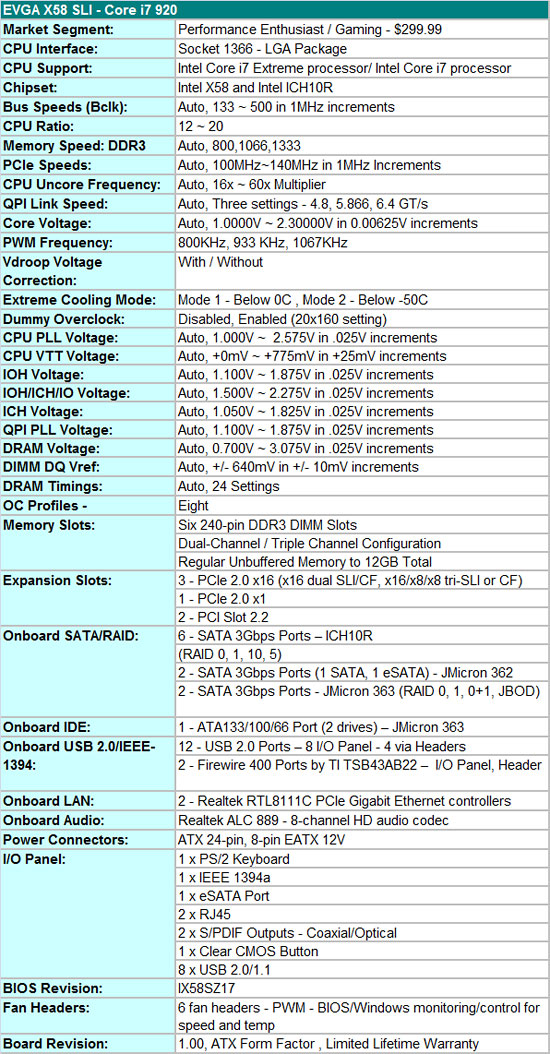
There aren't too many bells and whistles on the EVGA X58 SLI from a hardware feature viewpoint, and considering the market for this board we think that's a good design choice. The almost universal Realtek RTL-8111C PCIe Gigabit Ethernet controllers are utilized in tandem; the Realtek ALC-889 is on board for HD audio; and JMicron’s JMB362/363 chipsets get the nod for eSATA, IDE, and additional SATA port duties. TI is selected for IEEE 1394a support and the Intel ICH10R is utilized for primary storage purposes. We have never been real big fans of either Realtek audio or JMicron IDE, but considering the dearth of competition in the onboard peripheral market, you make do with the provided choices.
The BIOS is designed to get the most out of the board when overclocking. At first glance, some of the available options like the number of memory timings seem sparse compared to the ASUS and Gigabyte offerings. However, EVGA does a very good job of setting sub-timings to optimal points so far in our testing. We still prefer the ability to set additional memory timings and skew levels ourselves, but we can certainly live with the decisions made by the BIOS, although those at the bleeding edge of benchmarking would probably prefer the additional control level in either the ASUS or Gigabyte products. We just received BIOS IX58SZ17 that features additional memory settings and fine tuning options. We will update our comments and results once we have finished testing.
In a nod to the users who like to cool their systems via cascade or LN2, EVGA provides two different modes to properly set the board at POST for sub-zero temperatures. Those who love or need voltages to improve clock speeds will not have any problems with the choices provided by EVGA. DRAM voltages sky rocket up to 3.075V and VCore goes to a nice silicon melting 2.3000V. VDroop control can be enabled or disabled. In fact, the board has a tendency to slightly overvolt with VDroop control disabled.
Also, you can fine tune the frequency level on the digital PWMs. We normally left it at 800KHz to help reduce temperatures in the CPU area but switched to 1067KHz when overclocking our i920 past 4GHz. We were able to get an additional 80MHz out of our CPU on air by switching from 800 to 1067 once we passed 4GHz. EVGA also provides a setting called a dummy overclock; quite simply, enable this setting and the board will set itself to run a 20x160 overclock on the i920. We found the settings to be perfectly stable during benchmark testing, though obviously that's a far cry from what manual overclockering can achieve.
EVGA also supports a stock 1333MHz memory speed on the i920/i940 processors along with opening up QPI link speeds from a standard 4.800 GT/s up to 6.400 GT/s, which is standard on the i965 Extreme processor. We were disappointed with the lack of OC profiles in the initial BIOS, but the latest BIOS allows a total of eight profiles to be saved.
Finally, the board fully supports 12GB of DDR3 memory. We have not had any real problems running 12GB of our Patriot or G.Skill DDR3-1600 kits at 1600 with 8-8-8-24 1T timings, although we needed about 1.70V for absolute stability. Dropping the command rate to 2T allows 1.65V operation with the current BIOS.
One last item of note is that the three PCI Express 2.0 x16 slots will operate in x16/x16 mode for 2x SLI/CF if the third x16 slot is empty. If you decide to place a PCIe RAID, network, audio, or TV tuner card in the third x16 slot, then a 2x SLI/CF configuration will operate in x16/x8 mode. We did not notice any performance differences between the two modes with our HD 4870 or GTX 260 cards. 3x SLI/CF configurations will run in x16/x8/x8 mode. You can also use the first and third x16 slots for graphics if you need to open up a PCI slot but the board will run in x16/x8 mode. Although the owner’s manual states the three x16 slots are for graphics cards only, we had no problems running our ASUS Xonar D2X or Highpoint Rocket RAID cards in x16 slots two or three.
The Board
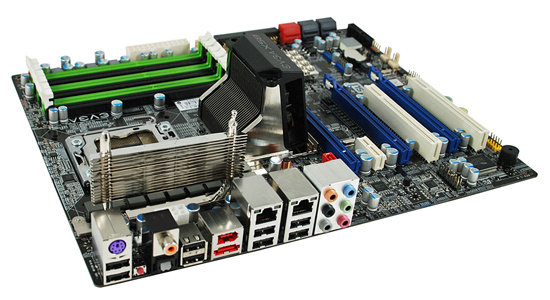
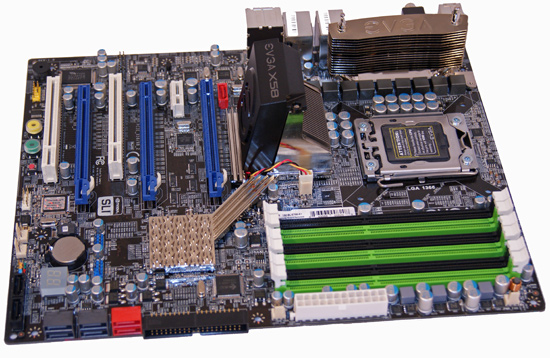
The primary design goal from EVGA was to allow 3x SLI/CF operation without needing a special case design to make room for the bottom video card. Put simply, this board will allow tri-card installations in most ATX cases but at the expense of rendering the additional PCIe and PCI slots physically unusable.
Keep that in mind when trying to figure out why EVGA located the lone x1 PCIe slot next to the first x16 slot. EVGA might as well have left it off the board (the same holds true for the other boards) and saved some money. We assume just about any owner willing to pay $299.99 for the board, at least $300 for a CPU, and $250 or so for 6GB of DDR3 will not be running a single slot GPU. In fact, unless you are going all out to set up up a folding machine or something similar, any GPU choice under an HD 4870 or GTX 260 is just a waste on this setup. Fortunately, the other PCIe x16 slots double for peripheral duty so those are available if needed.
The northbridge heatsink is fairly large and actively cooled. We could not hear the fan over our HD 4870 card, so noise should not be a problem. We were able to comfortably fit our large air coolers on the board without too much trouble once the PWM heatsink was moved slightly. The PWM heatsink looks nice, has an impressive EVGA logo stamped on the top fin, and is generally a pain in the you-know-what to work with when installing the 8-pin ATX power connector, large CPU heatsinks, or during case installation. It does a nice job of keeping the digital PWMs cool, but we just think something in a low rise design would have been better suited.
Some will wonder about the positioning of the 8-pin EPS12V power connector since it is a tight fit for most cables and the CPU fan header is right next to it just to make matters more interesting during installation. The position was chosen to provide the quickest and most stable power path to the CPU. We understand the reasoning and support EVGA’s decision, but a different PWM cooling solution would have made life easier.
Other than the above, the layout is very good and works well for us in a variety of cases. The board does come with power, reset, and clear CMOS buttons. In fact, two clear CMOS buttons are provided, one on the bottom edge of the board and the other on the IO panel. A handy LED debug display is available and six of the nine SATA ports are provided in a right angle setup.
The Application
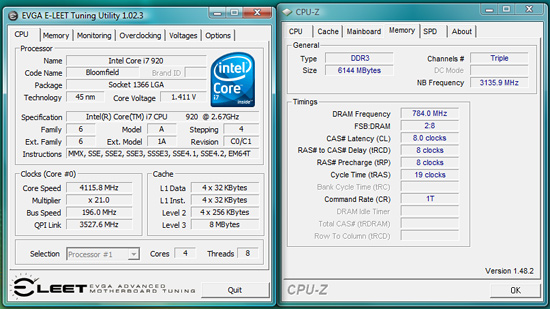
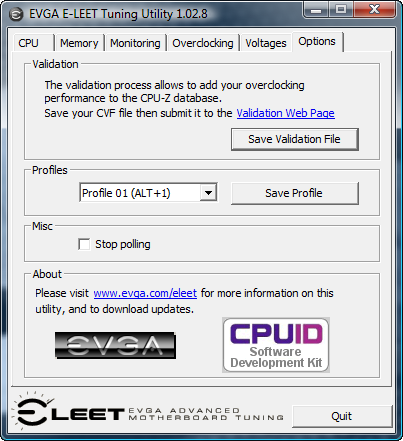
The ability of a board manufacturer to provide unique hardware or software features helps to differentiate products based on the same hardware. EVGA is hard at work in fully developing their Windows based on-the-fly overclocking utility. The application is known as the EVGA E-LEET Tuning Utility. We tested with version 1.02.08 that features profiles that can be saved and then applied quickly with a simple hot-key combination.
The E-LEET tuning utility was created with the CPUID software development kit, so users of CPU-Z will feel right at home. In fact, the utility will create a CVF file that can be submitted for validation to the CPU-Z database. There are six tabs with CPU, Memory, Monitoring, and Option being informational in nature. The Overclocking and Voltages tabs are where the action is with this program. The Voltages tab allows all of the major voltages to be changed on-the-fly and the Overclocking tab lets you adjust Bclk (QPI) , PCIe bus speed, and Turbo mode. Turbo mode selections cannot go higher than what the processor allows.
We found the utility to be handy in squeezing out that last Bclk step and to help ensure voltages are properly set at each overclocking step. The changes are not saved to the BIOS or a BIOS profile (hint, hint) and at this time the user will need to power down their system when exiting Windows to properly clear/reset the clock generator. We would like to see the ability to change the CPU multiplier and memory settings in future updates. Otherwise, the utility is very helpful but not a knockout, need-to-buy-the-board type of tool yet.






















78 Comments
View All Comments
whb456 - Monday, April 20, 2009 - link
They should be paying you for all the hard work you're doing for them. ;-)rreuscher - Thursday, February 19, 2009 - link
Hi,I don't know if this the right place to post this comment, but I try it.
I read that you always perform DPC latency tests in all your reviews, I'm missing this results for this Gigabyte X58-UD5 board.
I build last week a system with an i7/920 CPU (Bios F4) but the DPC latency is a nightmare (my dual core 4 year old laptop outperforms this system). I'm using/intended this machine for dedicated Real Time Audio production, which means I need a steady DPC latency.
The system shows very low DPC latency values with WIN XP and hyperthreading off (about 4 us), but with constantly spikes reaching up to 8000 us, and this is a killer.
Did you did some testing on this also ?
Kind regards, Rene Reuscher
sahina - Tuesday, January 27, 2009 - link
I am looking for 4GB memory sticks for this board but the only one in QVL is S10C1 4GB Samsung M378B5273BH1-CF8 DS Samsung K4B2G0846B HCF8. This is DDR3 1066. I can not find it for sale in the market.Has anyone tested this board with 24GB RAM?
Twoboxer - Monday, January 26, 2009 - link
Anand, your comments represent a start, but . . .If you are not part of the solution, you are part of the problem. Unfortunately, there is very little grey area between "reviewer" and "shill".
1) Ask mfgs to submit samples by Date X.
2) Test until the board will go no further.*
3) Publish report.
4) Rinse and repeat to recognize and publicize improvements, if any.
* If you want to make ONE phone call to each manufacturer, fine.
Allowing mfgs to cherry-pick parts is concession/advantage enough. ONE phone call is honorable. More than that is a disservice to your readers, and denies you your supposed purpose as a reviewer. The time saved during your first review will more than cover rinse/repeat.
In practice I can often get a better idea of what parts to buy after reading a couple of dozen consumer in-use reviews on, for example, Newegg.
You may find it painful or difficult to change course, but you are now at least on the right path. IMO, you can either continue on the return path to "reviewer", or watch Newegg become the de facto replacement for much of your work.
aussie greg - Saturday, January 24, 2009 - link
I want to join the chorus of 'cFoo' and probably many others.What you [Anand] have to say about all the 'SNAFU'S' relating to these boards, have been going on with many other boards for years, My Asus P5 would not work until the 3rd bios update and then failed shotly after...by the time it was replaced updates had reached 12...in 10 months! I was without a fully working mobo for 7 months!
It's not good enough, it's actually pathetic dishonest performance by the manufacturers and probably worth investigating by a relevant govt. authority. Anandtech...and others, should bite the bullet and name names, in detail.
Maybe if some of these companies got the kick up the arse [with apologies] they deserve, we consumers would be better off.
Ausssie Greg
Eru The One - Tuesday, January 20, 2009 - link
I have been pouring over reviews for the last three days comparing any x58 motherboard review I can find. I feel i've narrowed my choice down to the Gigabyte Extreme but I have yet to see anyone comparing DFI's new x58 against anything.I think I should wait before I see someone doing this before I make my final choice. Can you guys at AnandTech help me out here?
tyaiyama - Wednesday, December 17, 2008 - link
I am planning to build a system using P6T Deluxe:Pro: ATX form factor not E-ATX(previously?)
PATA is implemented by Marvel 88SE6111
Dual GbE
Triple channel DDR3
True16+2 Phase Power Design
100% High-quality Japan-made Conductive Polymer Capacitors
Con: Max memory 12 GB
3rd PCIe 2.0 x16 (not usable)
SAS Onboard
Some people may say FDD connector is not necessary, but I need it. I use SATA for all drives; thus I actually do not need PATA, but just in case. Triple channel DDR3 4GB module will be available next month. Since i7 is the memory controller at the same time, what maximum size does it support? I know it is at least 128GB. Through BIOS upgrade, can we use 24GB or more memory in P6T?
cFoo - Sunday, December 14, 2008 - link
Anand, I hope one day you will decide to let the cat out of the bag. Post all the problems and the manufacturer's name beside them. I understand that would risk them from giving you exclusive early access to the boards. But we desperate need accountability. You cannot let them stomp all over fair and accurate journalism.Accountability now! I'm sick of spending $300+ dollar and waiting 1-2 months for fixes. If I wanted to do that, I'll rather wait 1-2 months to buy the board for $100 cheaper!
mwm - Friday, December 12, 2008 - link
Thanks, Anand; I really appreciate the valuable info regarding your experience with partially-DOA motherboards. Where else would be get this information? How many hours would it take a builder to run down the problem? We don't have the bench or knowledge resources to do that. So we are just screwed.Keep up the good work. (I'd even like to see a cheat-sheet on exactly what did not work on a board: a little embarrassment and no sale from guys like myself might prompt them to pay more attention.)
Yours,
mwm
woodworker72 - Wednesday, December 10, 2008 - link
What happened to the Rampage II review? I see the detailed review of the P6 from ASUS. There was a review a few weeks ago that lacked details due to legal restrictions, but what about now? Thanks!